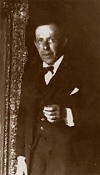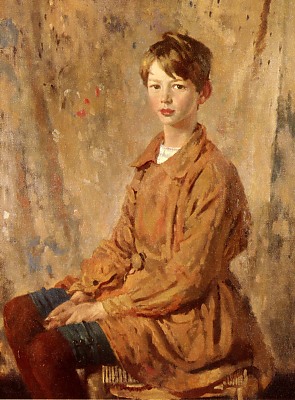The Art of Sir William
Orpen
The dazzling Irish
painter created portraits with an amazing force
of precision.

 ne
of my favorite artists has always been the great
Irish painter Sir William Orpen (1878 - 1931).
His masterful portraits are extraordinarily
vivid, the combined product of superb draftsmanship,
rich color, and an unerring control of tonal
values. He was first and foremost a painter—the strong, decisive brushstrokes are
placed with athletic vigor and uncanny accuracy.
There never seems to be an ounce of hesitancy
or indecision—every stroke registers
like a clear, precise note of music. I offer
four examples for you to study: ne
of my favorite artists has always been the great
Irish painter Sir William Orpen (1878 - 1931).
His masterful portraits are extraordinarily
vivid, the combined product of superb draftsmanship,
rich color, and an unerring control of tonal
values. He was first and foremost a painter—the strong, decisive brushstrokes are
placed with athletic vigor and uncanny accuracy.
There never seems to be an ounce of hesitancy
or indecision—every stroke registers
like a clear, precise note of music. I offer
four examples for you to study:
 |
1. Portrait of Master Spottiswoode
This very appealing portrait of
a young boy is based on a conventional
"artist's studio pose"—the lad takes his position
before a standard neutral studio
drape, looks "three-quarter
left," and maintains an erect
pose. But there is nothing conventional
or ordinary in the execution. The
background sparkles with rich, variegated
color. The four pieces of the boy's
costume register individual color
notes that resound like major chords:
the ochre smock has lush passages
of orange and yellow, the blue leggings
and the maroon stockings each strike
a musical note, and the white at
the boy's throat draws the eye upward.
Don't fail to notice Orpen's masterful
use of reflected light—it
shimmers in the shadows side of
the face and glows in the shadows
of the smock.
Oil
on canvas
38 x 30 inches
Private collection
|
| page 1 2
3 4 |
|
It is a rare
treat to see an Orpen original. Very few are
exhibited in American museums. The National
Portrait Gallery in Washington, DC, features
several. In his 1935(?) book The Technique of
Portrait Painting (Philadelphia, J.B. Lippincott
Company, publishers) artist and author Harrington
Mann pays tribute to Orpen:
|
"The untimely death of Sir William
Orpen has been a blow to modern British
art. We have lost a painter who, while
he had already achieved fame, would have
carried the laurels of the British school
of to-day to a still higher level had
he lived. His work shows an amazing force
of precision in the realization of individual
character. He never failed to tell you
all about his sitter—all that could
be told in paint by the cleverest hand
and the keenest eye. The face of the man
before him was like the page of an open
book which he read with astonishing insight
He made a literal transcript which he
handed on to anyone who cared to know.
"It is the physical character which
is of interest to the painter, but he
knows that if he can but get this skin-deep
truth he has got everything Technically
Orpen was splendidly equipped There was
no slashing sleight-of-hand like Boldini
There was neither the carefree dexterity
of Hals, nor the facile skill of Sargent,
but he had his own unerring precision
of touch which gave him the proficiency
necessary to produce his masterpieces
"Even with his Irish sense of humour
Orpen always told the truth. This is real
portraiture."
|
Every working portrait artist would do well
to study Orpen.
William Orpen,
the son of a Dublin solicitor was born in Stillorgan,
County Dublin in 1878. He studied at the Metropolitan
School of Art in Dublin and the Slade School
in London, where his fellow students included
Augustus John. Orpen soon became known for his
portraits of public figures and during his career
produced over six hundred of these pictures.
In 1916 Orpen's
friend, the Quartermaster General, Sir John
Cowans, arranged for him to receive a commission
in the Army Service Corps. This mainly involved
him painting the portraits of senior political
and military figures such as Winston Churchill
and Lord Derby. In 1919 Orpen was commissioned
to paint portraits of the politicians at the
Versailles Peace Conference.
After the war
Orpen returned to portrait painting, including
one of Prime Minister David Lloyd George (1926).
Sir William Orpen died in 1931.
|